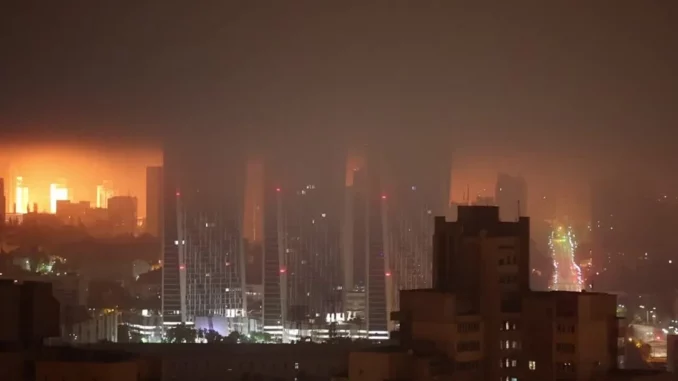
| Published May 27, 2025
Over the past several nights, Ukraine has faced the most intense wave of drone and missile attacks in the war with Russia, signaling a troubling escalation in a conflict now well into its third year. Russia deployed over 900 drones and numerous cruise missiles targeting more than 30 Ukrainian cities and towns, causing at least 18 deaths, including civilians and children, and widespread destruction.
This unprecedented assault, particularly the May 25 barrage involving 355 Shahed drones and nine Kh-101 cruise missiles, underscores Russia’s willingness to intensify hostilities despite mounting international condemnation. The attack not only inflicted tragic human losses but also tested Ukraine’s air defense capabilities and strained its already limited resources.
Ukrainian President Volodymyr Zelenskyy responded by urging the international community, especially the United States, to step up military support and diplomatic pressure against Moscow’s aggression. His call highlights the growing frustration over the perceived slow pace of aid, especially in providing advanced air defense systems like the Patriot missile batteries.
Meanwhile, former U.S. President Donald Trump offered his blunt assessment, calling Russian President Vladimir Putin “absolutely crazy” for escalating the conflict. However, Trump also criticized Zelenskyy’s rhetoric, reflecting the complex and often divided opinions on how the West should engage in this conflict.
As Ukrainian forces continue to defend key eastern territories in Kharkiv, Luhansk, and Donetsk, the international community faces a critical moment. The decisions made now regarding military aid, sanctions, and diplomatic efforts will likely shape the trajectory of this war and its impact on European and global security for years to come.
An apartment building hit by a Russian strike in Kyiv on May 24, 2025.
Balconies in a residential building destroyed by the attack in Kyiv.
Rescue workers at the scene of a Russian strike in Kyiv.
Ukrainian firefighters and rescuers work at a storage facility of a factory that was hit by a Russian strike in Vasyshcheve, Ukraine on May 26, 2025.
Ukrainian firefighters and rescuers work at a storage facility of a factory that was hit by a Russian strike in Vasyshcheve, Ukraine on May 26, 2025.
Firefighters working to extinguish a fire at a residential building in Kyiv.
The broader implications of this intensified offensive extend beyond battlefield casualties. They raise concerns about the conflict’s potential to destabilize the region further, disrupt global energy markets, and exacerbate geopolitical tensions between Russia, the West, and other global players.
Implications of Russia’s Largest Drone and Missile Assault on Ukraine
Humanitarian Implications:
-
Increased civilian casualties and displacement: The attacks exacerbate the suffering of civilians, many of whom are forced to flee their homes, worsening the refugee crisis in Ukraine and neighboring countries.
-
Strain on healthcare and infrastructure: Targeted strikes on cities and critical infrastructure disrupt medical services, access to clean water, electricity, and food supplies, intensifying humanitarian needs.
-
Psychological trauma: Prolonged exposure to violence impacts mental health, especially among children and vulnerable populations.
Geopolitical Implications:
-
Heightened East-West tensions: The escalation reinforces the divide between Russia and NATO countries, complicating diplomatic relations and increasing the risk of broader confrontation.
-
Increased pressure on Western allies: Calls for more military aid and sanctions place Western governments in difficult positions balancing support for Ukraine with avoiding wider conflict.
-
Influence on global alliances: The conflict tests alliances beyond Europe, including China’s role and reactions from other global powers, potentially reshaping international alignments.
Global Economic Implications:
-
Energy market volatility: Russia’s aggression risks further disruption to oil and gas supplies, impacting global energy prices and economic stability, especially in Europe.
-
Food security risks: Ukraine is a major grain exporter; conflict-induced production and export disruptions threaten food supplies worldwide, particularly in vulnerable regions.
-
Supply chain disruptions: Continued conflict may exacerbate global supply chain issues, affecting industries reliant on raw materials from the region.
Overall Takeaway:
The recent escalation of Russia’s drone and missile attacks on Ukraine marks a dangerous intensification of a complex and protracted conflict with far-reaching consequences. Beyond the immediate human toll—marked by loss of life, displacement, and infrastructure damage—the conflict exacerbates geopolitical tensions between Russia and the West, challenges global security frameworks, and disrupts vital economic systems like energy and food supplies. Addressing this crisis requires a coordinated international response that balances urgent humanitarian aid with strategic diplomatic and military measures to prevent further devastation and promote long-term stability.









